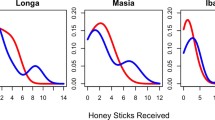Abstract
Observations of Hadza men foraging out of camp and sharing food in camp show that men seeking to maximize the flow of calories to their families should pursue large game, and that hunting large game does not pose a collective action problem. These data also show that Hadza men frequently pursued honey, small game, and fruit, and that by doing so, provided a more regular flow of food to their households than would a putative big game specialist. These data support our earlier studies demonstrating that the goal of family provisioning is a robust predictor of Hadza men’s behavior. As before, the show-off and costly signaling hypotheses advanced by Hawkes and colleagues fail as both descriptions of and explanations for Hadza men’s work.
Similar content being viewed by others
Notes
i.e., “non-experimental,” in the terminology of Hawkes et al. 2014.
Marlowe has also carried out a large set of focal follows; a more thorough prey choice analysis incorporating these data will be the subject of a future publication.
References
Berbesque, J. C., & Marlowe, F. (2009). Sex differences in food preferences of Hadza hunter-gatherers. Evolutionary Psychology, 7(4), 601–616.
Estes, R. (1991). The behavior guide to African mammals: Including hoofed mammals, carnivores, primates. Berkeley: Univeristy of California Press.
Hawkes, K. (1991). Showing off: tests of an hypothesis about men’s foraging. Ethology and Sociobiology, 12(1), 29–54.
Hawkes, K., Hill, K., & O’Connell, J. F. (1982). Why hunters gather: optimal foraging and the Ache of eastern Paraguay. American Ethnologist, 9(2), 379–398.
Hawkes, K., O’Connell, J. F., & Blurton Jones, N. G. (1997). Hadza women’s time allocation, offspring provisioning and the evolution of post-menopausal lifespans. Current Anthropology, 38(4), 551–577.
Hawkes, K., O’Connell, J. F., & Blurton Jones, N. G. (2001). Hadza meat sharing. Evolution and Human Behavior, 22(2), 113–142.
Hawkes, K., O’Connell, J. F., & Blurton Jones N. G. (2014). More lessons from the Hadza about men’s work. Human Nature 25(4). doi:10.1007/s12110-014-9212-5
Jaeggi, A. V., & Gurven, M. (2013). Reciprocity explains food sharing in humans and other primates independent of kin selection and tolerated scrounging: a phylogenetic meta-analysis. Proceedings of the Royal Society B: Biological Sciences, 280(1768), 20131615.
Kingdon, J. (2013). The Kingdon field guide to African mammals. London: A&C Black.
Marlowe, F. W. (2004). Mate preferences among Hadza hunter-gatherers. Human Nature, 15(4), 365–376.
Marlowe, F. W., & Berbesque, J. C. (2009). Tubers as fallback foods and their impact on Hadza hunter-gatherers. American Journal of Physical Anthropology, 140(4), 751–758.
Marlowe, F., Berbesque, J. C., Wood, B. M., Crittenden, A., Porter, C., & Mabulla, A. (2014). Honey, hunter-gatherers, and human evolution. Journal of Human Evolution, 71, 119–128.
O’Connell, J. F., & Hawkes, K. (1981). Alyawara plant use and optimal foraging theory. In B. Winterhalder & E. A. Smith (Eds.), Hunter-gatherer foraging strategies: Ethnographic and archaeological analyses (pp. 99–125). Chicago: University of Chicago Press.
Oiseaux.net (2014). Ecopains d’abord 2014. Available from http://www.oiseaux.net/.
Wood, B. M. (2006). Prestige or provisioning? A test of foraging goals among the Hadza. Current Anthropology, 47(2), 383–387.
Wood, B. M., & Marlowe, F. W. (2013). Household and kin provisioning by Hadza men. Human Nature, 24(3), 280–317.
Wood, B. M., Pontzer, H., Raichlen, D. A., & Marlowe, F. (2014). Mutualism and manipulation in Hadza-honeyguide interactions. Evolution and Human Behavior. doi:10.1016/j.evolhumbehav.2014.07.007.
Acknowledgements
For funding, we thank the National Science Foundation (awards 1062879, 0242455), the Leakey Foundation, the Wenner-Gren Foundation, and Yale University. We thank Bret Beheim, Mike Gurven, Kim Hill, Adrian Jaeggi, Mike Gurven, and Jeremy Koster for stimulating discussions.
Author information
Authors and Affiliations
Corresponding author
Electronic supplementary material
Below is the link to the electronic supplementary material.
ESM 1
(DOCX 32.4 kb)
Rights and permissions
About this article
Cite this article
Wood, B.M., Marlowe, F.W. Toward a Reality-Based Understanding of Hadza Men’s Work. Hum Nat 25, 620–630 (2014). https://doi.org/10.1007/s12110-014-9218-z
Published:
Issue Date:
DOI: https://doi.org/10.1007/s12110-014-9218-z




